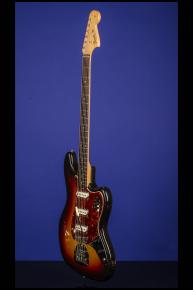Early 1962 Fender Bass VI With All of the Earliest Features
1962 Fender Bass VI
This early 1962 Fender Bass VI has all of the earliest features, including three two-way selector switches and a slab rosewood fretboard. It weighs in at 9.10 lbs. and has a nut width of just under 1 9/16 inches and a short bass scale length of 30 inches. Solid ash body with contoured back. One-piece maple neck with a medium to thin profile. Brazilian 'slab' rosewood fretboard with 21 original medium-thin frets and clay dot position markers. Single "butterfly" string with 1/8 inch metal spacer. Headstock decal with "Fender VI" logo in gold with black trim and "Electric Bass Guitar" and three patent numbers in black below it. Small circular "Offset Contour Body" decal on the ball end of the headstock. Individual 'single-line' Kluson Deluxe tuners with oval metal buttons and "D-169400 / Patent No." stamped on the underside. Four-bolt neck plate with serial number "79665" between the top two screws. Three individually height-adjustable Stratocaster-style (white six-polepiece) pickups with chrome surrounds and outputs of 5.58k, 5.71k, and 6.38k. Four-layer tortoiseshell over white and black plastic pickguard with thirteen screws. Two controls (one volume, one tone) and jack input on lower metal plate adjoining pickguard and three two-way pickup selector switches on metal plate inset into pickguard. Seven-sided black plastic knobs with white markings. Six-saddle bridge and separate vibrato tailpiece. The neck is stamped "6 MAR 62A" and the pots are stamped "304 6212" (CTS March 1962). Under the pickguard, between the neck and middle pickup cavities are the 3/8 inch letters "E.J." (most likely a previous owner) which have been engraved into to the wood. This is one of the very best examples that we have ever seen of one of the earliest Bass VIs. Fender made only a very few Bass VIs with the original "slab" Brazilian rosewood fretboard (in mid 1962 they changed to a veneer rosewood fretboard and four selector switches instead of three). Complete with the original tremolo arm with cream plastic tip. Housed in its original Fender light brown Tolex hardshell case with brown leather ends and dark orange plush lining (9.00).
"After noting the popularity of the Danelectro 6-string bass (tuned EADGBE, like a guitar, but an octave lower) in the Nashville studios, Leo decided to build his own version. He introduced the Fender Bass VI in 1961. The original version looked vaguely like a Jazz Bass but had a 30" scale length, three pickups, and three sliding switches that allowed seven different pickup combinations. That wasn't enough for Leo, apparently, so a year later he added a fourth switch -- the so-called 'strangle switch' that cut low frequencies. The pickups were also modified and a mute added. The Bass VI was never very popular, but it remained in the catalog until 1975 and was later revived, in a Japanese-made reissue, in 1995" (Jim Roberts, American Basses, p. 55).
"Every musician will readily recognize the potential of the New Fender six-string Bass Guitar inasmuch as it offers an entirely 'new sound' to every playing group. Tuned one octave below the standard guitar, numerous new tone combinations are made possible with three full range pickups. The circuit incorporates three two position switches enabling the player to select the pickups individually or in any combination. In addition, a tone control positioned adjacent to the volume control permits further tone modifications of any selector position. The Bass Guitar is a fine addition to the Fender line and answers the demand for a high-quality six-string bass" (July 1961 Namm Daily advertisement in J.W. Black and Albert Molinaro, The Fender Bass, p. 31).
"The Fender Vl found favor with many British musicians during the '60s. Former Shadows bassist Jet Harris, featured one on his chart-topping 1963 hit 'Diamonds'. Eric Haydock of the Hollies, and John Entwistle of The Who regularly used Fender Vls, and Jack Bruce played a sunburst Fender Vl in Manfred Mann before forming Cream with Eric Clapton and Ginger Baker in 1966. During his stint in Cream, his bass received its now-famous psychedelic paint scheme courtesy of Dutch art collective The Fool. Peter Green used a Bass Vl during his time with Fleetwood Mac and Beatles guitarists George Harrison and John Lennon favored the Bass Vl when accompanying Paul McCartney as he switched to piano for songs like 'Hey Jude', 'Let It Be' and "The Long And Winding Road'. In America the Fender Vl was a popular studio instrument and appeared on countless recordings during the '60s. It was endorsed by Buddy Merrill, Neil LeVang and Billy Strange, and was used to produce the famous deep twang heard on Glen Campbell's 'Wichita Lineman'." (Martin Kelly, Terry Foster & Paul Kelly. The Golden Age of Fender 1946-1970. p. 158).












